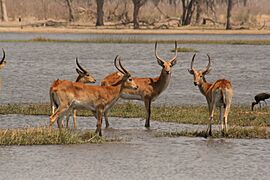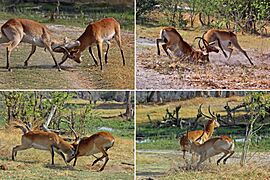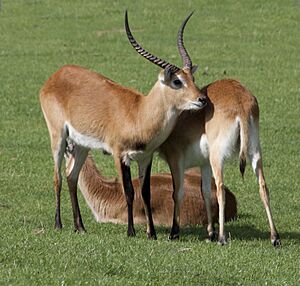Lechwe facts for kids
Quick facts for kids Lechwe |
|
|---|---|
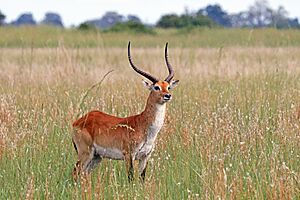 |
|
| male K. l. leche Nkasa Rupara National Park, Namibia |
|
| Conservation status | |
| Scientific classification | |
| Subspecies | |
|
|
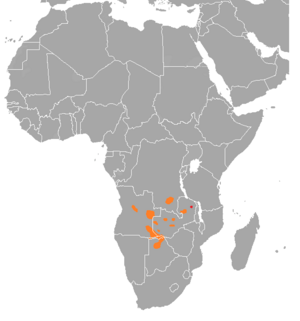 |
|
| Distribution range of lechwe | |
| Synonyms | |
|
Onotragus leche |
The lechwe, also known as the red lechwe or southern lechwe (Kobus leche), is a type of antelope. You can find these amazing animals living in the wetlands of south-central Africa.
Contents
Where Lechwes Live
Lechwes originally come from countries like Botswana, Zambia, and parts of the Democratic Republic of the Congo, Namibia, and Angola. They especially love places like the Okavango Delta, Kafue Flats, and Bangweulu Wetlands. You can also often see lechwes in zoos and on special wild animal farms around the world.
What Lechwes Look Like
Adult lechwes usually stand about 90 to 100 centimeters (35 to 39 inches) tall at the shoulder. They weigh between 50 and 120 kilograms (110 to 260 pounds). Male lechwes are typically larger than females.
Their fur is golden brown, and they have white bellies. Male lechwes are often darker in color. The amount of black on their front legs, chest, and body can change depending on their specific subspecies. Only male lechwes have long, spiral horns. These horns are shaped a bit like a lyre, which is a type of harp.
Lechwes have hind legs that are a bit longer than other antelopes. This helps them run quickly over marshy, wet ground.
Lechwe Habitats
Lechwes live in marshy areas. They are important herbivores, meaning they eat plants. They munch on aquatic plants and grasses found in flooded meadows.
These clever animals use knee-deep water to protect themselves from predators. Their legs have a special water-repellent coating. This allows them to run very fast even in water that reaches their knees. Lechwes are diurnal, which means they are active during the day.
They gather in large groups, sometimes with thousands of other lechwes! Usually, these herds are made up of only one sex. However, during mating season, males and females mix together.
Types of Lechwes
Scientists have identified four main types, or subspecies, of the lechwe.
Lechwe Subspecies
- Common red lechwe (Kobus leche leche) (Gray, 1850)
- Kafue Flats lechwe (Kobus leche kafuensis) (Haltenorth, 1963)
- This type lives only in the Kafue Flats. This is a flood-plain in Zambia that gets flooded during certain seasons by the Kafue River.
- † Roberts' lechwe (Kobus leche robertsi) (Rothschild, 1907)
- This subspecies used to live in northeastern Zambia, but it is now extinct. It was also called the Kawambwa lechwe.
- Black lechwe (Kobus leche smithemani) (Lydekker, 1900)
- You can find these lechwes in the Bangweulu region of Zambia.
Some experts also consider the Upemba lechwe (Kobus anselli) and the extinct Cape lechwe (Kobus venterae) to be subspecies of the lechwe. They are sometimes called Kobus leche anselli and Kobus leche venterae.
Even though it shares the name "lechwe," the Nile lechwe (K. megaceros) is always considered a completely separate species.
Lechwe Reproduction
Lechwes usually mate during the rainy season, which is from November to February. Their pregnancy lasts about seven to eight months. This means most baby lechwes, called calves, are born between July and September.
Sometimes, though it's rare, lechwes and waterbuck have had babies together. These babies are called hybrids.



